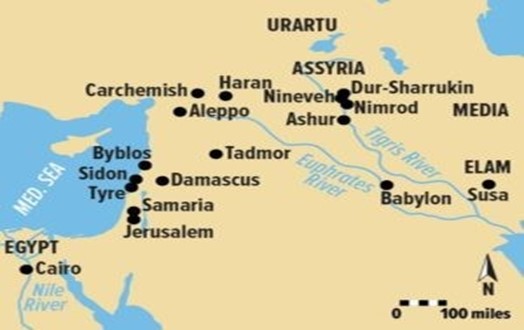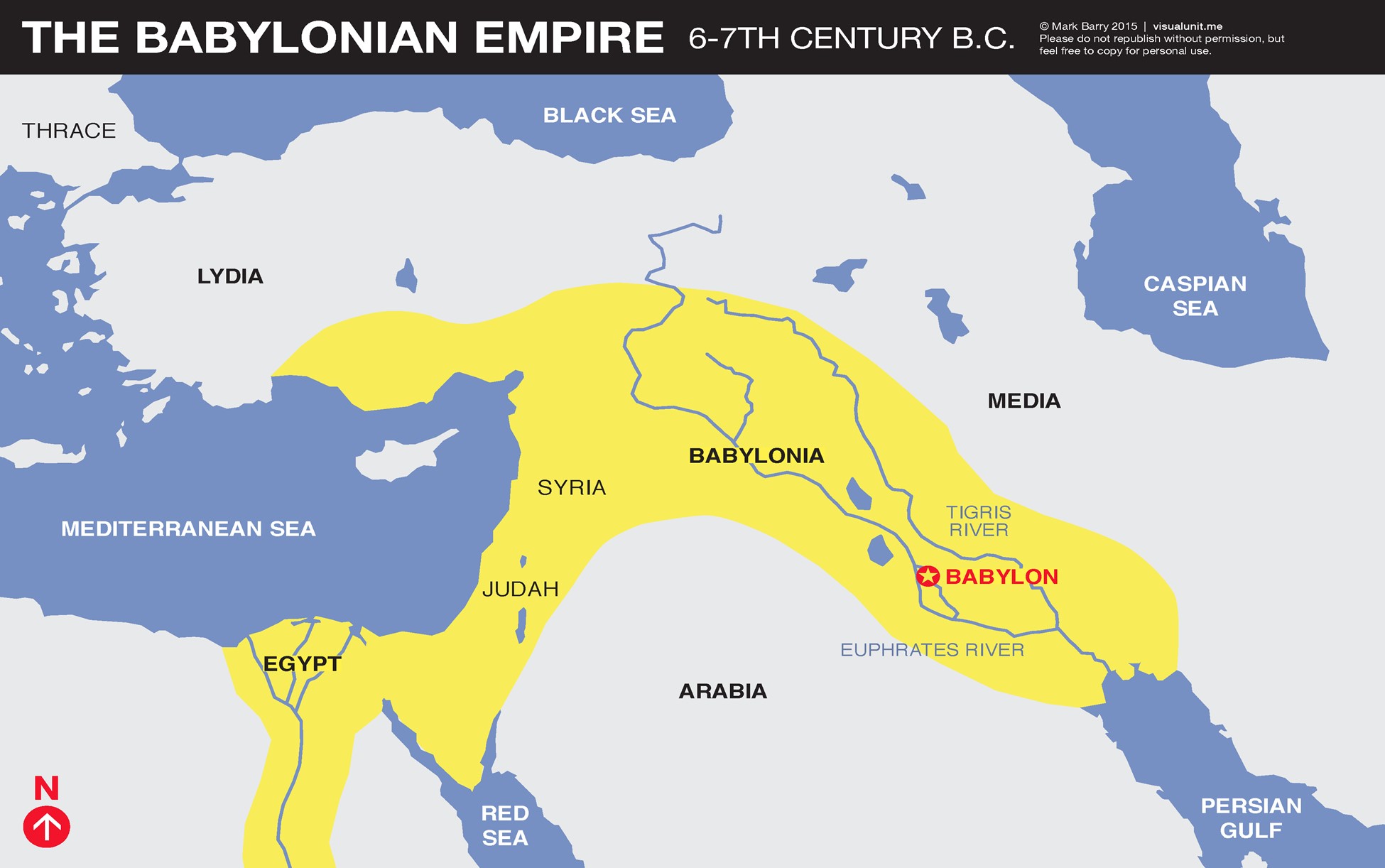
THE BOOK OF HABAKKUK
INTRODUCTION
The Book of Habakkuk is part of the collection of the minor prophets in the Hebrew and Christian canon of Sacred Scripture, coming eighth, after Nahum and before Zephaniah. Habakkuk describes himself as a watchman faithfully listening to Yahweh's message, which he saw in visions (1:1; 2:1). The book divides into two parts: a collection of poetic oracles (massah) that the prophet saw (1:1-2:20) and his psalm/prayer (tephillah) to God (3:1-19). The oracles in the first two chapters are also divided into two sections. The first part is in two sections, and the second is a prayer that also falls into two parts and ends with a renewed profession of the prophet's faith in his God.
| BIBLICAL PERIOD | #8: After the Assyrian conquest and exile of the Northern Kingdom of Israel and before the Babylonian conquest of the Southern Kingdom of Judah | ||
| FOCUS | The oracles of God received by Habakkuk | Habakkuk's Psalm | |
| COVENANT | THE SINAI COVENANT | ||
| SCRIPTURE | 1:1---------------------------2:5----------------------------------3:1------------------------------19 | ||
| DIVISIONS | Dialogue between Habakkuk and God | God's judgment on the oppressors | Habakkuk's prayer of praise |
| TOPIC | Habakkuk complains to God, and God replies | The five "woes" against Judah's enemies | Habakkuk renews his faith in God |
| LOCATION | THE SOUTHERN KINGDOM OF JUDAH | ||
| TIME | Circa 625-597 BC | ||
We do not have any information about Habakkuk's family or hometown or when he delivered his ministry, as in other prophetic books that mention the reigns of kings. However, his description of himself as "stationed on my watchtower," the first line of his psalm in 3:1 (tone as for dirges), the instructions to "pause," repeated three times, and the last line of his psalm at the end of the book in 3:19 (For the choirmaster, on stringed instruments) might suggest that he was a Levitical minister in the Jerusalem Temple.
In the first oracle, the Chaldeans (Neo-Babylonians), who succeeded the Assyrians as the most powerful force in the Levant, are depicted as weapons wielded by God against Israel's oppressors. References to the Assyrians make a direct link between Habakkuk's ministry and the oracles against Assyria in the previous prophetic book of Nahum. As far as content is concerned, Habakkuk is like Isaiah, Jeremiah, and Micah, but also similar to some of the Psalms and the Book of Job.
The book shows that Habakkuk is a man of faith who believes that Yahweh is the sovereign Lord who rules the destinies of all nations and has a covenant bond with His chosen people, Israel (1:17; 2:5-20). Pagan idols are only man-made objects (2:18-19), but Yahweh is the living God who rules Heaven and Earth. And yet, there is something the prophet cannot reconcile: If Yahweh has a special covenant love for His chosen people, how can He treat them so harshly? To find the answer to this question, Habakkuk converses with God, addressing this difficult issue (chapters 1-2). In the Lord's replies, He explains to His prophet that the sins committed by the Gentile nations and Israel are grievous offenses against His sovereignty. Especially harmful are the covenant people's sins since their mission is to stand as a holy example to the Gentiles, not to excuse sin. The sins of both must be addressed and punished. However, the righteous will be saved, provided they persevere in faith and fidelity to God (2:4). This is Habakkuk's central message, and the book develops this one idea.
The prophet's underlying question is why evil exists in the world. Why is it that sometimes the wicked prosper and the righteous suffer? The Book of Job posed the same question but addressed it to the condition of the individual person. Habakkuk seeks an answer for the collective level of the chosen covenant people and other nations. When divine revelation is fully revealed in the coming of the Divine Messiah, the question of why evil exists will be answered.
The visions the prophet Habakkuk received probably continued from 605 to 597 BC. These were the years between the Battle of Carchemish on the Euphrates River in northern Syria when Babylonian general Nebuchadnezzar defeated the Egyptians and took control of the region in 605 BC, and the Babylonian invasion of Judah in 597 BC (Jer 42:6), but before the Babylonians conquered Jerusalem in 587/6 BC. During these years, the situation in the Kingdom of Judah was desperate, with the sin of idol worship and the practice of political intrigue widespread in the kingdom.
All Scripture quotations are from the New Jerusalem Bible unless listed as from the Interlinear Bible Hebrew-English, Vol. III (IBHE), or the New American Bible Revised Edition (NABRE). The New Jerusalem Bible uses God's Divine Name, YHWH (Yahweh with vowels), where it appears in the Hebrew text. Other translations replace the Divine Name with LORD or GOD in capital letters. Yahweh is the name by which we are commanded to petition the Lord in Exodus 3:15b, "This is my name for all time, and thus I am to be invoked for all generations to come." See the chart on the Prophets of Yahweh.
HISTORICAL BACKGROUND
Maps of the Assyrian and Babylonian Empires:


In c. 930 BC, the United Kingdom of Israel (ruled in turn by kings Saul, David, and Solomon) split into two states: the Northern Kingdom of Israel and the Southern Kingdom of Judah, which continued to be ruled by Davidic kings. Jeroboam I, king of the Northern Kingdom, expelled the Aaronic and Levitical priesthood and established idol worship (1 Kng 12:20-33). For breaking the first three of the Ten Commandments, Yahweh's prophets promised divine judgment against the Northern Kingdom. After two centuries of warnings, God finally delivered judgment against the Northern Kingdom, using the Neo-Assyrian Empire as His instrument of judgment.
In the second millennium BC, the Neo-Assyrian Empire succeeded two earlier phases of Assyrian history: the Old and Middle Assyrian periods. The Neo-Assyrian Empire was located in Mesopotamia and existed between 912 and 612 BC, creating the largest empire the world had seen at that time. Adad Nirari II (r. 911-891) was the first king of the Neo-Assyrian period. The Neo-Assyrian empire embarked on a massive territorial expansion, eventually conquering and ruling over Mesopotamia, part of Anatolia (Asia Minor/modern Turkey), the Levant, and Egypt. In their conquests, they destroyed entire cities, kings and their officials were flayed or impaled, whole armies were decapitated, and they enslaved whole populations, sending them into exile.
In 732 BC, the Assyrians invaded the northern Levant, including the Northern Kingdom's province of Galilee. The Assyrians laid siege to Samaria, the capital of the Northern Kingdom, for three years and finally conquered it in 721 BC. They deported its citizens to Assyria and brought in five pagan peoples to settle the land. They adopted the worship of Yahweh together with their pagan gods and became known as the Samaritans (2 Kng 17:18, 24-41).
The Southern Kingdom of Judah was next on the Assyrian list for conquest, but King Hezekiah of Judah called his people to repentance and destroyed all pagan altars. Yahweh accepted their pleas for mercy and struck the Assyrian army of King Sennacherib, encircling Jerusalem, with a plague, causing them to withdraw back to Assyria. (2 Kng 19:35-37). The withdrawal from the siege of Jerusalem was recorded in tablets discovered in the Assyrian archives, but not the reason for it.
Unfortunately, other kings of Judah succeeded righteous King Hezekiah, who returned to idol worship and despised God's laws. Again, God's holy prophets delivered messages of impending doom for the Southern Kingdom. This time, God's instrument of judgment would be the Neo-Babylonians, who were subject to the Assyrians.
In 626 BC, a Chaldean-Babylonian (Merodach-baladan) seized the throne of Babylon and revolted against the Assyrians. The Assyrian capital of Ninevah fell to the Babylonians and their allies, the Medes, in 612 BC, and the last Assyrian king was defeated. Under the command of Babylonian King Nabopolassar's son, Nebuchadnezzar, the Babylonian army defeated the Egyptians at Carchemish in 605 BC. That same year, Nebuchadnezzar II succeeded his father as king of Babylon and advanced on the Levant and the Kingdom of Judah. Nebuchadnezzar II conquered Jerusalem in 597 BC, and the Judean king agreed to become a vassal of the Babylonians, but he revolted in 588 BC, sealing Judah's fate. Habakkuk's ministry was probably sometime before the battle at Carchemish from 625-597 BC and before the Babylonian conquest of the Southern Kingdom and Jerusalem in 587/6 BC and the exile of the majority of the population into Babylonian lands (2 Kng 25:1-21).
Michal Hunt, Copyright © 2024 Agape Bible Study. Permissions All Rights Reserved.